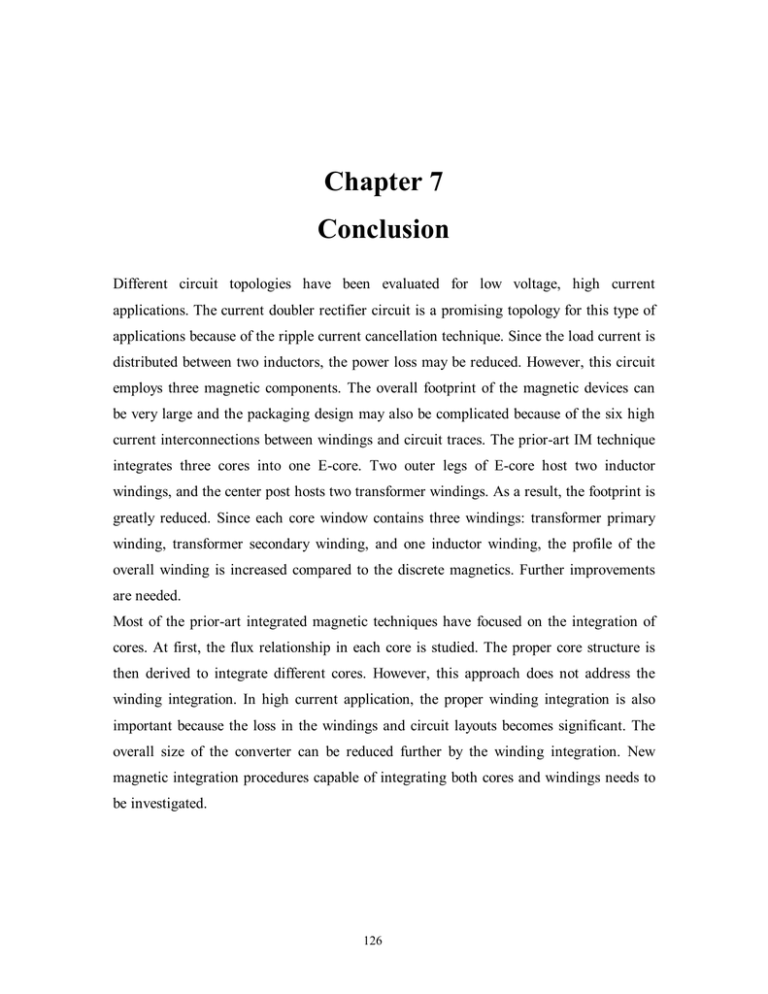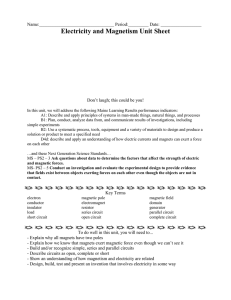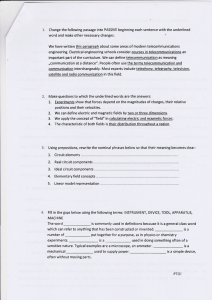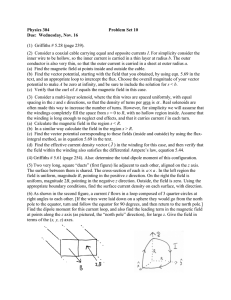ch7
advertisement

Chapter 7 Conclusion Different circuit topologies have been evaluated for low voltage, high current applications. The current doubler rectifier circuit is a promising topology for this type of applications because of the ripple current cancellation technique. Since the load current is distributed between two inductors, the power loss may be reduced. However, this circuit employs three magnetic components. The overall footprint of the magnetic devices can be very large and the packaging design may also be complicated because of the six high current interconnections between windings and circuit traces. The prior-art IM technique integrates three cores into one E-core. Two outer legs of E-core host two inductor windings, and the center post hosts two transformer windings. As a result, the footprint is greatly reduced. Since each core window contains three windings: transformer primary winding, transformer secondary winding, and one inductor winding, the profile of the overall winding is increased compared to the discrete magnetics. Further improvements are needed. Most of the prior-art integrated magnetic techniques have focused on the integration of cores. At first, the flux relationship in each core is studied. The proper core structure is then derived to integrate different cores. However, this approach does not address the winding integration. In high current application, the proper winding integration is also important because the loss in the windings and circuit layouts becomes significant. The overall size of the converter can be reduced further by the winding integration. New magnetic integration procedures capable of integrating both cores and windings needs to be investigated. 126 7.1. Summary The theoretical work has focused on three areas: topology development and magnetic integration, analysis of integrated magnetic structures, development of a simple and satisfactory design guideline for low voltage integrated magnetic circuits. The experimental results are presented to verify the proposed circuit topologies. 7.1.1. Topology development and magnetic integration A new magnetic integration procedure is proposed and has been successfully applied to the development of integrated magnetic structures for different types of circuits. At first, all of the magnetic components were lumped together to form an m-port electrical network. There are m+1 steps needed to complete the magnetic integration of this network. Step 1: a current source is injected to Port 1 with other ports open. The inductance into this port is then expressed as the function of the parameters of each magnetic component (winding turns, reluctances, etc.). Because this inductance must be implemented on a single magnetic core (requirement of the magnetic integration), the flux coupled by this reluctance can expressed as the function of port current, and the parameters of each magnetic component (winding turns, reluctances, etc.). The corresponding magnetic reluctance circuit and the physical implementation are then derived from the relationship of amp-turns, fluxes, and reluctances. Step 2-m: repeat Step 1 for the rest m-1 ports. Step m+1: By applying the super-position theory, the final magnetic structure can be derived. This procedure is able to integrate both of the cores and the windings. Since only the port current instead of winding current is considered, the winding integration is made possible. As a result of applying this integration procedure, an improved IM circuit for the current doubler rectifier circuit is developed. With only two secondary side windings, the transformer profile is lower than the prior-art IM for the current doubler rectifier circuit. The single-turn implementation yields the minimum footprint, simplest secondary side layout, and lowest fabrication cost. Therefore, these types of circuits are the most 127 promising topology for low voltage, high current, high density applications. The diagram of the improved IM structure for the current doubler rectifier circuit is shown to be identical to the integrated magnetic integration of dual-transformer circuits. Logically, the dual-transformer circuit is electrically equivalent to the current doubler rectifier circuit. Half-bridge circuits with asymmetrical duty cycle control are only suitable for narrow input range because of the parabolic gain curve. An improved current doubler rectifier circuit and its integrated magnetic structure was developed. It adopts an additional transformer. The resulting circuits are able to extend the practical input voltage range and minimize the voltage/current stress on the semiconductor devices as well. The diagram of the IM structure for this circuit is the same as that of the improved IM circuit for the regular current doubler circuit. The only difference is that the ratio of two outer leg windings in this circuit is adjusted to provide the function of the extra transformer. In certain applications, a multi-turn secondary winding structure is required. The previously proposed IM circuits are not suitable for the multi-turn secondary configuration because of the dramatically increased leakage inductance and larger winding footprint. A new rectifier circuit is therefore developed. By properly designing the turns ratio, the ripple current cancellation technique can still be realized. The IM structure features the minimum number of windings and interconnections. The footprint of the PCB winding can be minimized for the multi-turn secondary configuration. 7.1.2. Analysis of Integrated Magnetic Structure To optimize the performance of the proposed integrated magnetic circuit, it is necessary to thoroughly understand the operation principles of these circuits. The analysis of the integrated magnetic circuit is different from that of the conventional circuit since the complicated magnetic structure is included and the flux distributions within this magnetic core are not the same as those in the discrete magnetic cores. Consequently, the analysis of the magnetic structure and the electrical circuit performance are integrated. The following analytical results were obtained for Forward circuit with Improved IM circuit (FI2M) and HB circuit with Improved IM circuit (HBI2M). The methodology adopted for the analysis can be extended to the analysis of other integrated magnetic circuits. 128 When two secondary windings have the same number of turns, DC characteristics of the proposed FI2M and HBI2M are equivalent to the regular forward and HB circuits, respectively. If two secondary windings have different turns, however, the proposed circuits are not equivalent to the regular forward and HB circuits. The design of N2>N1 can extend the practical input range and reduce voltage/current stress in semiconductor devices in some applications. Ripple current cancellation technique is inherent in the proposed integrated magnetic circuit. The analysis shows that the ripple current is more dependent on the duty cycle and the ratio of two outer leg equivalent inductances than the switching frequency and the absolute inductance values, respectively. By designing a proper duty cycle range and a proper ratio between two outer leg inductances, the converter can meet output ripple requirement at lower switching frequency without increasing the size of the magnetics and capacitors. Theoretically, there is a critical duty cycle point where zero output ripple current can be achieved. In practice, however, zero output ripple current cannot be obtained because of the leakage indutances. The leakage inductances should be minimized in the winding design. Three design factors play important roles in the output ripple current: the transformer primary-to-secondary turns ratio N; the ratio between two outer leg cross-sectional areas; and the ratio between two outer-leg gappings. Since each factor can independently modify the output ripple current, a simple design guideline is to choose N to minimize the voltage/current stress in the semiconductor devices, to use the ratio of two outer leg cross-sectional areas (assume the ratio between two outer leg gappings is fixed) to minimize the ripple current, and to design the gappings to prevent the flux saturation. For a lower fabrication cost, commercial off-the-shelf (COTS) cores and uniform outer leg gapping (e.g., a spacer gapping) are usually preferred. Since the structures of these COTS cores are symmetrical, the outer leg cross-sectional areas are equal. By adopting the even gapping for two outer legs, the critical duty cycle for the minimum output ripple current is 50%. To minimize the worst-case output ripple current, therefore, the turns ratio N should be chosen to yield a duty cycle range centered at 50% for the given input and output requirements. 129 The flux distribution inside the integrated magnetic core is not uniform. Each core leg sees both dc flux and ac flux. One core leg always carries higher dc flux than the other two. In the proposed HBI2M and FI2M circuits, the dc flux level in outer leg 2 is the highest. Therefore, outer leg 2 stores more energy than outer leg 1. The gapping must be properly designed to prevent the local flux saturation in this core leg. The ac flux in each core leg is determined by the volt-seconds per turn seen by its winding. As the duty cycle changes, the ac flux density in each core leg also changes. Under different duty cycles, the core loss in each portion of the core is different. To prevent a local hot spot, precautions can be taken by limiting the maximum ac flux density in each core leg under the worst-case conditions. If a symmetrical core structure is adopted, the total core loss reaches minimum at 50% duty cycle. The core loss in two outer legs are also balanced. There is no local hot spot under this condition. The winding loss is dependent on the different primary side topologies. But at 50% duty cycle, the loss in each winding is relatively balanced. To simplify the thermal management, it is also recommended to design the transformer turns ratio such that the duty cycle range is centered around 50%. 7.1.3. Design Guideline for Low Voltage Integrated Magnetic Circuit The design of low voltage integrated magnetic circuits involves two important aspects: design of integrated magnetic devices and design of gate drives for synchronous rectifiers. An optimal design of the IM devices should minimize the size and loss of the magnetic device and the magnitude of the output ripple current. Meanwhile, the manufacturing cost and fabrication complexity should also be minimized. A proper gate drive is the key to minimize the conduction loss in the synchronous rectifiers. A direct self-driven scheme is most suitable for high efficiency high density applications. However, there are several limitations with this gate drive scheme. Improvements are needed. For the given electrical requirement, the transformer turns ratio N is chosen to minimze the voltage stress and current stress in the semiconductor devices. The duty cycle range is obtained as the result of the selection of N. The design of an integrated magnetic core then involves three steps: 130 i. design of the core cross-sectional areas; ii. design of gappings for each leg; iii. design of the window areas. The cross-sectional areas are designed to meet the maximum ac flux density requirement and to minimize the output ripple current. By selecting the magnetic materials, switching frequency, and the core loss density, the maximum allowable ac flux density in each core leg can be obtained. The minimum cross-sectional areas in each core portion are then calculated. By choosing a fixed ratio of two outer leg gappings (usually, the ratio is selected to be one in order to lower the manufacturing cost), the critical duty cycle for the “zero” output ripple current can be determined directly by the ratio of two outer leg cross-sectional areas. In order to minimize the worst case ripple current, the ratio of two outer leg cross-sectional areas are designed such that the resulting critical duty cycle is in the middle of the given duty cycle range. The gappings are then designed to prevent the flux saturation in each core leg. Usually, because of cost concerns, two types of gapping designs are preferred: two equal outer leg gaps with no gap in the center post, or a spacer gap for all three legs. Chapter 4 provides the design equations for the gapping in FI2M and HBI2M circuits. By choosing the winding filling factor and the maximum current density in conductors, the minimum window areas can be estimated from the current stress of the enclosed windings. Design equations for FI2M and HBI2M circuits are also given. Several improved self-driven synchronous rectification techniques are proposed. The proposed techniques possess the following virtues. i. They are applicable to the circuit topologies whose transformer winding voltage has zero state. ii. They are capable of direct module-parallel operations iii. They are able to protect gates from over-voltage iv. They can be adapted to very low output voltage 131 7.1.4. Experimental Results By applying the proposed low voltage IM circuits and the design guidelines, several better-than-state-of-art results have been obtained in the low voltage, high current applications: i. 130W/in3, 90% efficiency, 0.25” height, hybrid power module was developed for 60Vin, 3.3V/30A output, the switching frequency is 500KHz ii. >87% efficiency was achieved for 70V input, 2.5V/35A output iii. 81~85% efficiency was achieved for 48V(+/-10%) input, 1.2~1.8V/70A output The proposed circuits and the analytical tools prove to be very useful for the design of high current, low voltage power supplies. 7.2. Future Work 7.2.1. Magnetic Integration in Other High Density Applications By applying the proposed magnetic integration procedure to other applications, one should be able to integrate more magnetic components. In certain applications, both the core counts and winding counts may be reduced. Power loss and filter size can be minimized. The power density can be improved further. The magnetic integration in the multi-modules may be investigated. 7.2.2. Rectification Technique As the output voltage of the power modules continues to drop, the synchronous rectifiers have an inevitable advantage over the Schottky rectifiers in terms of thermal management. With the coming of new materials and new device techniques, such as GaAs VFET [D4], new efficient driving schemes for the synchronous rectifiers can be developed in order to improve efficiency and power density. 7.2.3. Packaging Technique The conventional Print-Circuit-Board (PCB) technique may fall out of favor as the requirement of the output current continues to increase. Thick copper is needed for higher output current application, resulting in a dramatic increase in the manufacturing cost of PCB. Since the substrate materials of PCB are not a good thermal conductors, thermal 132 management will be a tough task when the power supply current exceeds a certain level. Insulated metal substrate (IMS) or direct bond copper (DBC) on ceramic substrate may have to be adopted. However, only a couple of layers of copper can be fabricated on this type of board. The thickness of the copper is also limited. At very high current applications, the conduction loss in the packaging is still high. Seeking a packaging technique with low manufacturing cost, low conduction loss, and good thermal conductivity is necessary 133




